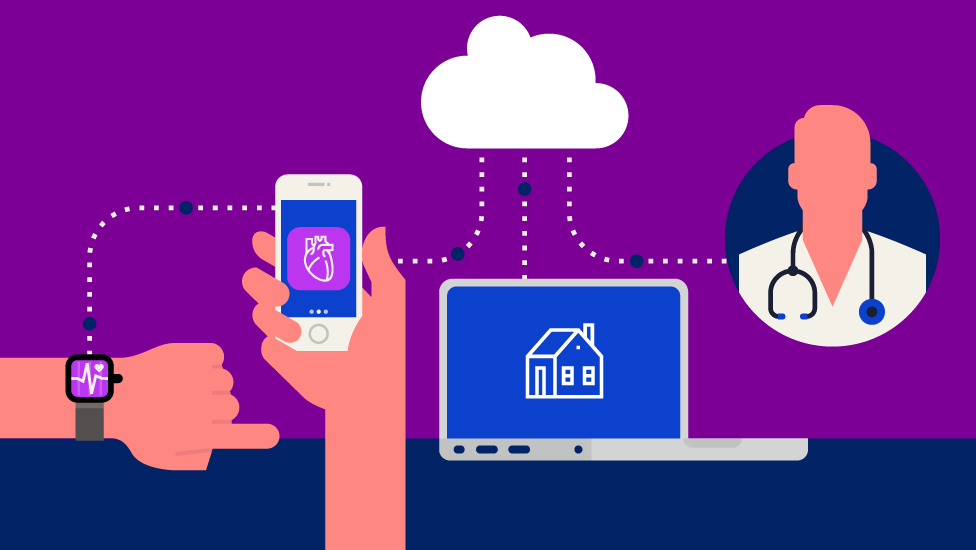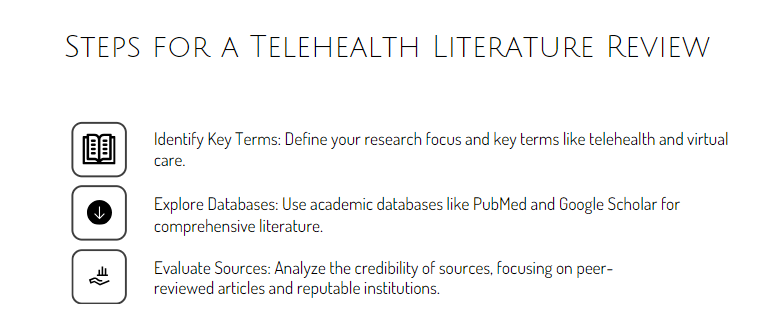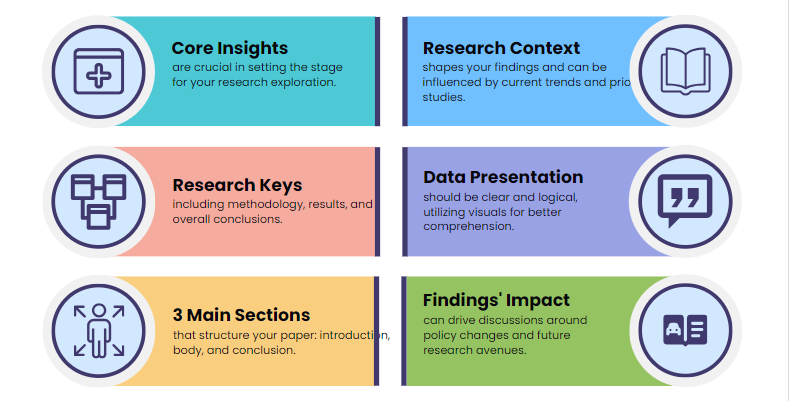
Table of Contents
The rise of telehealth, driven by technological advancements and a growing demand for accessible healthcare, has transformed the medical landscape. This shift towards virtual care presents an exciting opportunity for research, exploring its impact on patient outcomes, healthcare delivery, and the future of medicine. Writing a compelling research paper about telehealth requires a nuanced understanding of the topic, careful research methodology, and a clear, engaging writing style.
This guide aims to equip you with the tools and knowledge needed to produce a strong and impactful research paper about telehealth.
Steps to Crafting a Stellar Research Paper about Telehealth
1. Defining the Scope: Choosing Your Niche
The vastness of telehealth necessitates a specific focus for your research paper about telehealth. Identify a particular aspect of telehealth to explore, whether it’s a specific technology, patient demographic, healthcare condition, or a specific area of impact like cost-effectiveness or patient satisfaction. Here are some potential research directions:
- Technology-Specific Research: Examine the effectiveness of a specific telehealth technology, such as video conferencing, mobile health apps, or remote patient monitoring devices.
- Patient-Centric Research: Investigate the impact of telehealth on patient satisfaction, adherence to treatment, or health outcomes for specific patient groups, like rural populations or those with chronic conditions.
- Provider-Focused Research: Analyze the challenges and opportunities of implementing telehealth for healthcare providers, exploring factors like training requirements, workflow integration, and legal considerations.
- Cost-Effectiveness and Economic Impact: Assess the financial implications of telehealth, investigating its potential to reduce healthcare costs, improve resource allocation, or increase access to care in underserved areas.
- Policy and Ethical Considerations: Explore the legal and ethical implications of telehealth, focusing on issues like data privacy, informed consent, and equitable access to virtual care.
2. Building a Solid Foundation: The Literature Review
Before embarking on your own research, a comprehensive understanding of existing literature is crucial. A thorough literature review forms the backbone of your research paper about telehealth. Here’s how to approach it:
- Identify Key Terms: Clearly define your research topic and identify relevant keywords for your search. Include terms like “telehealth,” “telemedicine,” “virtual care,” “remote patient monitoring,” “mHealth,” “e-health,” and specific technologies or conditions relevant to your niche.
- Explore Different Databases: Use databases such as PubMed, Scopus, Web of Science, and Google Scholar to search for relevant articles, books, and reports.
- Evaluate Sources: Critically analyze the quality and relevance of each source, focusing on peer-reviewed publications, reputable research institutions, and government agencies.
- Synthesize and Organize: Summarize the key findings and perspectives from your readings, highlighting gaps in existing research and identifying areas for further investigation.
- Develop a Research Question: Based on your literature review, formulate a clear and focused research question that guides the direction of your research paper about telehealth.

3. Crafting a Research Methodology: Designing Your Study
The chosen methodology for your research paper about telehealth will depend on your research question and the type of data you aim to collect. Here are some common approaches:
- Quantitative Research: Employs numerical data and statistical analysis to investigate relationships and patterns in telehealth practices. This could involve surveys, questionnaires, or analyzing existing data sets.
- Qualitative Research: Explores the subjective experiences and perspectives of individuals involved in telehealth, using interviews, focus groups, or case studies.
- Mixed Methods Research: Combines quantitative and qualitative approaches, providing a comprehensive understanding of the complex dynamics of telehealth.
- Intervention Study: Involves introducing a specific intervention or program related to telehealth, measuring its impact on participants.
- Systematic Review or Meta-Analysis: Compiles and analyzes the findings from multiple existing studies to draw conclusions about a specific aspect of telehealth.
4. Conducting Your Research: Data Collection and Analysis
Once your methodology is established, you can begin data collection and analysis. Here’s how to approach this crucial stage:
- Ethical Considerations: Ensure your research complies with ethical guidelines, obtaining informed consent from participants and protecting data privacy.
- Data Collection: Employ your chosen method to collect data relevant to your research question, utilizing surveys, interviews, focus groups, medical records, or existing databases.
- Data Cleaning and Analysis: Organize, clean, and analyze your collected data using appropriate statistical software or qualitative analysis techniques, depending on your methodology.
5. Presenting Your Findings: Crafting a Clear and Convincing Narrative
After analyzing your research data, it’s time to present your findings in a clear and compelling manner. Your research paper about telehealth should effectively communicate your research question, methodology, findings, and conclusions.
- Structure and Organization: Follow a standard research paper structure:
- Introduction: Introduce your research topic, provide background information, state your research question, and outline your research approach.
- Literature Review: Summarize relevant existing research, highlighting key findings and identifying gaps in knowledge.
- Methodology: Describe your research design, data collection methods, and data analysis techniques.
- Results: Present your findings in a clear and organized manner, using tables, figures, and descriptive text.
- Discussion: Interpret your findings in relation to your research question and existing literature, highlighting the significance of your study and its implications for practice, policy, or further research.
- Conclusion: Summarize your key findings and reiterate the importance of your research.
- Writing Style: Use clear, concise, and objective language. Avoid jargon and technical terms that may be unfamiliar to your audience. Cite sources appropriately to support your claims.

6. Sharing Your Insights: Disseminating Your Research
After completing your research paper about telehealth, consider ways to share your findings with a wider audience.
- Journal Publication: Aim to publish your research in a peer-reviewed journal relevant to your field. This provides a platform for scholarly dissemination and contributes to the body of knowledge on telehealth.
- Conference Presentations: Presenting your research at relevant conferences allows for direct engagement with the research community and fosters discussion and collaboration.
- Public Outreach: Consider engaging with the public through presentations, blog posts, or social media to increase awareness about your research findings and their implications.
Examples of Research Paper Topics about Telehealth
Here are some specific research paper about telehealth topics to spark your interest:
- The Impact of Telehealth on Patient Adherence in Chronic Disease Management: Explore the effectiveness of telehealth in improving patient adherence to medication regimens and other treatment protocols for conditions like diabetes, heart disease, and mental health disorders.
- Cost-Effectiveness of Telehealth for Rural Healthcare Delivery: Analyze the financial implications of implementing telehealth programs in rural areas, examining its potential to reduce healthcare costs, improve access to specialty care, and enhance patient outcomes.
- Patient Perceptions of Telehealth: A Qualitative Study: Conduct interviews or focus groups to investigate patient experiences with telehealth, exploring their perceptions of the technology, its benefits and limitations, and their overall satisfaction with virtual care.
- The Role of Telehealth in Improving Mental Health Outcomes: Examine the effectiveness of telehealth interventions for mental health conditions like depression, anxiety, and substance abuse, focusing on factors such as access to care, cost-effectiveness, and patient satisfaction.
- The Ethical Implications of Telehealth: A Review of Data Privacy and Informed Consent: Analyze the legal and ethical considerations surrounding data privacy and informed consent in telehealth, exploring the potential risks and benefits of virtual care in relation to patient confidentiality and the use of personal health information.
Tips for Writing a Winning Research Paper about Telehealth
- Stay up-to-date: Telehealth is a rapidly evolving field. Ensure your research incorporates the latest advancements and current trends.
- Focus on impact: Highlight the practical implications of your research for healthcare providers, patients, policymakers, and the broader healthcare system.
- Address limitations: Acknowledge the limitations of your research, such as sample size, methodological constraints, or potential biases.
- Engage with your audience: Write in a clear and engaging style, using evidence-based arguments and supporting your claims with credible sources.
- Seek feedback: Get feedback from peers, mentors, or experts in the field to refine your writing and improve the quality of your research.
Avoiding Common Mistakes in Research Papers about Telehealth
The field of telehealth is rapidly expanding, offering innovative solutions to healthcare challenges. Consequently, writing a strong research paper about telehealth is crucial to advancing the conversation and driving impactful change. However, navigating the complexities of this field can lead researchers into common pitfalls that hinder the quality and impact of their work. This article aims to identify these common mistakes and provide practical solutions to ensure your research paper about telehealth stands out.
1. Lack of Clear Research Question: A common mistake in research papers about telehealth is the absence of a well-defined research question. Without a clear focus, the research can become diffuse and lack direction. Instead of simply exploring telehealth broadly, formulate a specific, measurable, achievable, relevant, and time-bound (SMART) research question. For instance, “Does video conferencing telehealth improve patient satisfaction in chronic disease management?”
2. Inadequate Literature Review: A thorough literature review is essential for a strong research paper about telehealth. Many authors fall short by only focusing on the latest publications or neglecting to consider diverse perspectives. A robust literature review requires exploring a range of sources, including peer-reviewed articles, grey literature, and relevant policy documents. This comprehensive approach ensures a well-informed and nuanced understanding of the existing research landscape.
3. Overreliance on Qualitative Data: While qualitative data is valuable in exploring patients’ and providers’ experiences with telehealth, relying solely on it can limit the generalizability of findings. A balanced approach, incorporating quantitative data to assess outcomes and effectiveness, strengthens your research paper about telehealth. Combining qualitative and quantitative methods can offer a more complete understanding of the complexities of telehealth implementation.
4. Neglecting Ethical Considerations: The use of telehealth raises unique ethical considerations, particularly regarding data privacy, informed consent, and equitable access. A strong research paper about telehealth must acknowledge and address these ethical dimensions. This can involve discussing ethical frameworks, conducting a risk-benefit analysis, and considering the potential impact on vulnerable populations.

5. Lack of Practical Implications: Research papers about telehealth should not merely describe findings but also offer practical implications for healthcare providers, policymakers, and researchers. Consider incorporating a “discussion” section that translates research findings into actionable steps. For example, suggesting strategies for improving telehealth training, identifying barriers to widespread adoption, or outlining potential future research directions.
6. Inadequate Discussion of Limitations: Every research paper about telehealth has limitations, whether it’s sample size, data collection methods, or specific contextual factors. Addressing these limitations honestly and openly strengthens the credibility of your research. Acknowledging limitations also helps readers interpret the findings with a critical eye and understand the scope of generalizability.
7. Poor Presentation and Clarity: A well-written research paper about telehealth is not only informative but also engaging and accessible to a broader audience. Ensure clear, concise language, effective use of visuals, and a logical flow of information. A well-structured paper, with clear headings and subheadings, facilitates understanding and maximizes the impact of your research.
Writing a strong research paper about telehealth requires careful planning and attention to detail. By avoiding common pitfalls and incorporating the best practices discussed above, researchers can contribute valuable knowledge to this rapidly evolving field. Remember, the goal is not just to present findings but to inspire impactful change, contributing to the wider adoption and optimization of telehealth solutions for the betterment of healthcare delivery.
Telehealth: Your Research Questions Answered
The field of telehealth is rapidly evolving, offering new ways to deliver healthcare and address patient needs. This has spurred a surge in research exploring its efficacy, implementation, and impact. If you’re embarking on a research paper about telehealth, you’re likely to encounter a multitude of questions. Let’s delve into some of the most frequently asked questions to guide your research process:
1. What are the key benefits and challenges of telehealth?
This foundational question is a cornerstone of any research paper about telehealth. Explore the advantages, such as improved accessibility, reduced healthcare costs, and increased patient satisfaction. However, also consider the challenges, including technological barriers, privacy concerns, and regulatory complexities.
2. What are the different types of telehealth services?
Research papers about telehealth often focus on a specific service. Understanding the diverse landscape is crucial. Explore options like telemedicine consultations, remote patient monitoring, and tele-rehabilitation. Consider the specific needs of your target audience and the type of healthcare service you are analyzing.
3. How effective is telehealth in delivering healthcare?
This is a central question driving much of the research surrounding telehealth. Analyze the evidence for its effectiveness in treating specific conditions, managing chronic diseases, and improving patient outcomes. Focus on studies that compare telehealth interventions to traditional methods, providing a strong basis for your conclusions.
4. What are the ethical considerations involved in telehealth?
Research papers about telehealth often address ethical dilemmas like patient privacy, data security, and informed consent. Discuss how these considerations influence the design and implementation of telehealth services. Examine existing guidelines and regulations to ensure responsible and ethical practices.
5. How does telehealth impact healthcare systems and healthcare professionals?
This question probes the broader implications of telehealth. Analyze its potential to improve healthcare delivery, reduce administrative burden, and enhance healthcare professional workload. Explore the impact on training, education, and professional development in the context of telehealth.
6. What are the future directions of telehealth research?
While your research paper about telehealth may focus on current trends, exploring future directions is vital. Examine emerging technologies, such as artificial intelligence and virtual reality, and their potential applications in telehealth. Analyze ongoing research on the integration of telehealth into existing healthcare systems and the development of new models of care.
7. What are the specific challenges and opportunities for telehealth in my area of interest?
This question requires you to tailor your research paper about telehealth to a specific context. Consider your chosen area of interest, such as mental health, pediatrics, or rural healthcare. Identify the unique challenges and opportunities presented by telehealth in this context and offer evidence-based solutions.
8. What are the key sources of data for my research paper about telehealth?
Your research paper about telehealth relies on credible data. Explore various sources, including peer-reviewed journals, government databases, patient surveys, and healthcare provider interviews. Utilize diverse methods of data analysis to ensure a comprehensive understanding of your chosen topic.
9. How can I effectively communicate my findings from my research paper about telehealth?
Effective communication is crucial for impactful research. Develop a clear and concise writing style, utilize visual aids and data visualizations, and engage with your audience through compelling arguments and insightful observations. Consider the broader implications of your findings and their potential impact on the future of telehealth.
By carefully addressing these frequently asked questions, your research paper about telehealth will be informed, impactful, and relevant to the ever-evolving landscape of healthcare delivery.

The Bottom Line
Writing a compelling research paper about telehealth requires a deep understanding of the topic, a rigorous research approach, and a clear, engaging writing style. By following the guidelines outlined in this article, you can navigate the digital frontier of telehealth research and contribute valuable insights to the growing body of knowledge in this dynamic field.
Remember, the purpose of your research paper about telehealth is to contribute to the ongoing dialogue surrounding the impact and potential of this revolutionary approach to healthcare. With careful planning, rigorous research, and a commitment to clear communication, you can create a research paper that makes a meaningful contribution to the field and informs the future of telehealth.
Get Professional Research Paper Writing Help
At PhD Nurse Writer, we can help you to craft an authentic and impactful research paper about telehealth. Our service covers topic suggestion, research paper writing, proofreading, editing, formatting and plagiarism removal. Besides, we can also assist you with writing essays, case studies and dissertations.





